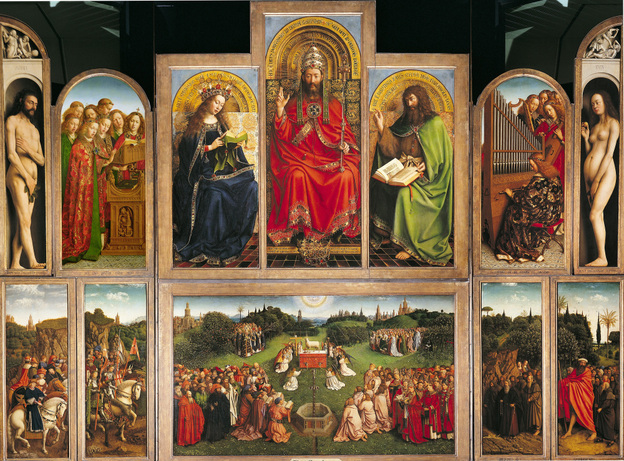
Hubert Eyck/The Bridgeman Art Library/Getty Images
The Ghent Altarpiece, or Adoration of the Mystic Lamb, completed in 1432 by Jan van Eyck
While enjoying the overall aura of holiday cheer on Christmas day, I could not help but ponder on an article I read earlier that day. The article entitled "Is This The World's Most Coveted Painting?" (Link Below), discussed the history of Jan van Eyck's Adoration of the Mystic Lamb. I find that the actual history of the painting sounds like something out of a Hollywood film. As intriguing as the history is, that is not the reason for this post.
In 1934, the lower left panel of the painting was stolen, and the panel has never been recovered. Since then a copy of the missing panel has been placed in the original's absence. Was this a good idea? Later in the article, it states that the copy was so good that people actually believed it to be the original. If a piece of art work is stolen or misplaced, is it fair to the viewing audience if a copy is placed on view until the original is returned (if ever)?
NPR Article: http://www.npr.org/2010/12/25/132283848/is-this-the-worlds-most-coveted-painting
1 comment:
This story is fascinating. Thank you for bringing it to our attention. To your question, I think that it is "fair" -- to use your word -- to have a copy of a portion of the work that is no longer extant inserted as part of the work itself. This would be predicated on knowledge of how the missing piece looked, exactly, which we do have, in this case. Having said this, I would hope that the object label copy (wall text) explains this. Granted, one cannot put EVERYTHING into a wall text, but important information should be revealed in addition to formal and contextual content.
While the theft has never been solved, and we have a copy of the missing panel in its stead, I wonder what difference that knowledge makes to informed viewers -- let's say, an artist, an art historian, a curator? What of the "regular visitor"? Does the panel to the right of the copy seem "more" van Eyck? Does it have "van Eyckness", if I can make up a word here? Or, does it strike the same visual pleasure, inquiry, and satisfaction (or disgust) as the other, larger portions of the altarpiece?
Post a Comment